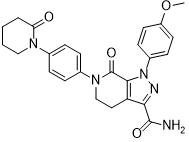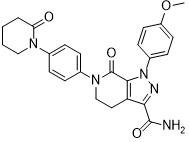
CAS 503612-47-3 APIS Active Pharmaceutical Ingredients Apixaban BMS562247 C25H25N5O4
-
High Light
CAS 503612-47-3 Active Pharmaceutical Ingredients
,C25H25N5O4 Active Pharmaceutical Ingredients
,Apixaban Active Pharmaceutical Ingredients
-
Product Name1-(4-Methoxy-phenyl)-7-oxo-6-[4-(2-oxo-piperidin-1-yl)-phenyl]-4,5,6,7-tetrahydro-1H-pyrazolo[3,4-c]pyridine-3-carboxylic Acid AMide
-
CAS503612-47-3
-
MFC25H25N5O4
-
MW459.5
-
EINECS639-684-6
-
Product CategoriesInhibitors;Inhibitor;API
-
Boiling Point770.5±60.0 °C(Predicted)
-
Density1.42
-
Pka15.01±0.20(Predicted)
-
Place of OriginChina
-
Brand NameRUN
-
CertificationIOS9001
-
Model NumberRUN-Z
-
Minimum Order Quantity10g
-
Priceinquiry
-
Packaging Details50g 100g 500g 1kg 5kg 10kg
-
Delivery Time3-7 days
-
Payment TermsT/T, MoneyGram, BTCcoin
-
Supply Ability1kg --100kg
CAS 503612-47-3 APIS Active Pharmaceutical Ingredients Apixaban BMS562247 C25H25N5O4
SECTION 1: Basic information
| Apixaban Basic information |
| Indications and Usage Mechanisms of Action Clinical Research Drug Interactions Warnings and Precautions |
| Product Name: | Apixaban |
| Synonyms: | Apixaban;Apixaban, BMS 562247-01;1H-Pyrazolo[3,4-c]pyridine-3-carboxamide, 4,5,6,7-tetrahydro-1-(4-methoxyphenyl)-7-oxo-6-[4-(2-oxo-1-piperidinyl)phenyl]-;1-(4-Methoxyphenyl)-7-oxo-6-[4-(2-oxopiperidin-1-yl)phenyl]-4,5,6,7-tetrahydro-1H-pyrazolo[3,4-c]pyridine-3-carboxamide;BMS562247;BMS 562247-01;1-(4-Methoxy-phenyl)-7-oxo-6-[4-(2-oxo-piperidin-1-yl)-phenyl]-4,5,6,7-tetrahydro-1H-pyrazolo[3,4-c]pyridine-3-carboxylic acid aMide;1-(4-Methoxyphenyl)-7-oxo-6-[4-(2-oxopiperidin-1-yl)phenyl]-4, 5-dihydropyrazolo[3,4-c]pyridine-3-carboxaMide |
| CAS: | 503612-47-3 |
| MF: | C25H25N5O4 |
| MW: | 459.5 |
| EINECS: | 639-684-6 |
| Product Categories: | Inhibitors;Inhibitor;API |
| Mol File: | 503612-47-3.mol |
| Apixaban Chemical Properties |
| Boiling point | 770.5±60.0 °C(Predicted) |
| density | 1.42 |
| pka | 15.01±0.20(Predicted) |
| Apixaban Usage And Synthesis |
| Indications and Usage | Apixaban is a new form of oral anticoagulant drug developed by Bristol Myers Squibb and Pfizer. It is a new form of oral Xa factor inhibitor, and its commercial name is Eliquis. Apixaban is used to treat adult patients undergoing elective hip or knee replacement surgery to prevent venous thromboembolism (VTE) |
| Mechanisms of Action | Apixaban is an oral selective activated Xa factor inhibitor and can prevent thrombin generation and thrombosis. |
| Clinical Research | Apixaban is the third new oral anticoagulant to go on sale, following dabigatran and rivaroxaban, and it has already been approved in Europe for preventing venous thromboembolism in patients undergoing elective hip or knee replacement surgery. Out of these three oral anticoagulants approved in Europe, compared to the current standard preventative treatment against venous thromboembolism, enoxaparin, rivaroxaban excelled in the record experiment, and apixaban excelled in the advance experiment. Rivaroxaban’s curative effects were slightly superior, but it caused more severe bleeding than apixaban. Researchers attributed these differences to medication time, as rivaroxaban was taken 6-8 hours after surgery in the record experiment, while apixaban was used 18 hours after surgery in the advance experiment. These drugs have better curative effect when used closer to time of surgery, but also have an increased bleeding risk. Clinical research showed that compared to a daily subdermal injection of 40mg enoxaparin, 2 oral 2.5mg dosages of apixaban had better preventative effects against venous thromboembolism following hip or knee replacement surgery and did not increase bleeding risk. |
| Drug Interactions | 1.A double inhibitor of strong CYP3A4 and P-gp increases apixaban’s blood levels: decrease Eliquis dosage to 2.5mg or avoid simultaneous usage. 2.A inductor of strong CYP3A4 and P-gp can decrease apixaban’s blood levels: avoid simultaneous usage. |
| Warnings and Precautions |
|
SECTION 2: Hazard identification
2.1 Classification of the substance or mixture
Specific target organ toxicity – repeated exposure, Category 1
2.2 GHS label elements, including precautionary statements
| Pictogram(s) | |
|---|---|
| Signal word | Danger |
| Hazard statement(s) | H372 Causes damage to organs through prolonged or repeated exposure |
| Precautionary statement(s) | |
| Prevention |
P260 Do not breathe dust/fume/gas/mist/vapours/spray. P264 Wash ... thoroughly after handling. P270 Do not eat, drink or smoke when using this product. |
| Response | P319 Get medical help if you feel unwell. |
| Storage | none |
| Disposal | P501 Dispose of contents/container to an appropriate treatment and disposal facility in accordance with applicable laws and regulations, and product characteristics at time of disposal. |
2.3 Other hazards which do not result in classification
no data available
SECTION 3: Composition/information on ingredients
3.1 Substances
| Chemical name | Common names and synonyms | CAS number | EC number | Concentration |
|---|---|---|---|---|
| 1-(4-methoxyphenyl)-7-oxo-6-(4-(2-oxopiperidin-1-yl)phenyl)-4,5,6,7-tetrahydro-1H-pyrazolo[3,4-c]pyridine-3-carboxamide1-(4-methoxyphenyl)-7-oxo-6-[4-(2-oxopiperidin-1-yl)phenyl]-4,5-dihydropyrazolo[3,4-c]pyridine-3-carboxamide | 1-(4-methoxyphenyl)-7-oxo-6-(4-(2-oxopiperidin-1-yl)phenyl)-4,5,6,7-tetrahydro-1H-pyrazolo[3,4-c]pyridine-3-carboxamide1-(4-methoxyphenyl)-7-oxo-6-[4-(2-oxopiperidin-1-yl)phenyl]-4,5-dihydropyrazolo[3,4-c]pyridine-3-carboxamide | 503612-47-3 | - | 100% |
SECTION 4: First-aid measures
4.1 Description of necessary first-aid measures
If inhaled
Move the victim into fresh air. If breathing is difficult, give oxygen. If not breathing, give artificial respiration and consult a doctor immediately. Do not use mouth to mouth resuscitation if the victim ingested or inhaled the chemical.
Following skin contact
Take off contaminated clothing immediately. Wash off with soap and plenty of water. Consult a doctor.
Following eye contact
Rinse with pure water for at least 15 minutes. Consult a doctor.
Following ingestion
Rinse mouth with water. Do not induce vomiting. Never give anything by mouth to an unconscious person. Call a doctor or Poison Control Center immediately.
4.2 Most important symptoms/effects, acute and delayed
no data available
4.3 Indication of immediate medical attention and special treatment needed, if necessary
no data available
SECTION 5: Fire-fighting measures
5.1 Suitable extinguishing media
Use dry chemical, carbon dioxide or alcohol-resistant foam.
5.2 Specific hazards arising from the chemical
no data available
5.3 Special protective actions for fire-fighters
Wear self-contained breathing apparatus for firefighting if necessary.
SECTION 6: Accidental release measures
6.1 Personal precautions, protective equipment and emergency procedures
Avoid dust formation. Avoid breathing mist, gas or vapours.Avoid contacting with skin and eye. Use personal protective equipment.Wear chemical impermeable gloves. Ensure adequate ventilation.Remove all sources of ignition. Evacuate personnel to safe areas.Keep people away from and upwind of spill/leak.
6.2 Environmental precautions
Prevent further spillage or leakage if it is safe to do so. Do not let the chemical enter drains. Discharge into the environment must be avoided.
6.3 Methods and materials for containment and cleaning up
Collect and arrange disposal. Keep the chemical in suitable and closed containers for disposal. Remove all sources of ignition. Use spark-proof tools and explosion-proof equipment. Adhered or collected material should be promptly disposed of, in accordance with appropriate laws and regulations.
SECTION 7: Handling and storage
7.1 Precautions for safe handling
Handling in a well ventilated place. Wear suitable protective clothing. Avoid contact with skin and eyes. Avoid formation of dust and aerosols. Use non-sparking tools. Prevent fire caused by electrostatic discharge steam.
7.2 Conditions for safe storage, including any incompatibilities
Store the container tightly closed in a dry, cool and well-ventilated place. Store apart from foodstuff containers or incompatible materials.
SECTION 8: Exposure controls/personal protection
8.1 Control parameters
Occupational Exposure limit values
no data available
Biological limit values
no data available
8.2 Appropriate engineering controls
Ensure adequate ventilation. Handle in accordance with good industrial hygiene and safety practice. Set up emergency exits and the risk-elimination area.
8.3 Individual protection measures, such as personal protective equipment (PPE)
Eye/face protection
Wear tightly fitting safety goggles with side-shields conforming to EN 166(EU) or NIOSH (US).
Skin protection
Wear fire/flame resistant and impervious clothing. Handle with gloves. Gloves must be inspected prior to use. Wash and dry hands. The selected protective gloves have to satisfy the specifications of EU Directive 89/686/EEC and the standard EN 374 derived from it.
Respiratory protection
If the exposure limits are exceeded, irritation or other symptoms are experienced, use a full-face respirator.
Thermal hazards
no data available
